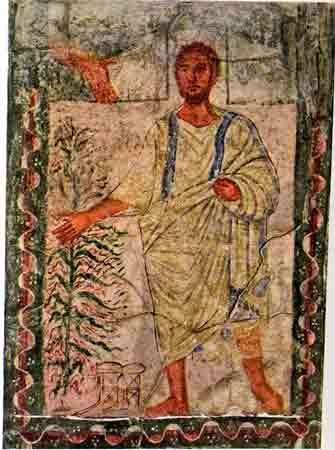
SYNAGOGUES: ANTIQUITY
After the destruction of the Temple in 70 c.e., the locus of Jewish religious and communal life became the synagogue (literally, "congregation"; also known in antiquity as the "prayer-house").
Like Herod's temple, the Jewish synagogue throughout its history--from antiquity to the present--has been an attempt to craft a distinctive Jewish cultural space from within the material idioms of Diaspora: often "like" other houses of worship (or public buildings in general), but creating a distinctive Jewish version of familiar, non-Jewish cultural forms.
For instance, the synagogue in the eastern Mediterranean city of Durra Europos (also the home to a church and several "pagan" temples, all buried in the destruction of the city in the mid-3rd century CE) combines the common Mediterranean concept of wall painting--figural, ornamental, artistic--with distinctively Jewish motifs:

Here we see the wall of the synagogue at Dura: in the middle is the Torah shrine, or ark, which would have held the torah scrolls. The surrounding walls are decorated with scenes from the TANAK, such as:

This scene showing Moses at the burning bush. The image is rendered as a typical Roman painting: Moses wears the noble form of Roman dress (the toga), and the "bush" is stylized in the manner of vegetation in a typical Roman painting from the third century.